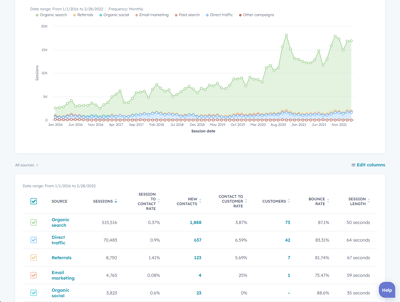Custom Web Design Vs. Template: What Is Right For Your Business?
Is your business still stuck in the digital stone age with an outdated website? It’s time to break free from the clutches of an online presence...

The internet has become a crowded marketplace, with businesses of all shapes and sizes vying for the attention of online consumers. In this fast-paced digital world, your website is often the first point of contact between your business and potential customers.
To stand out from the crowd, you need a visually appealing website that delivers a great user experience and high-quality content. And while your business may feel very personal to you, it’s important to remember that web design is less about personal expression and more about attracting and converting the right visitors into leads.
In fact, the best web design is like a science, with its own set of principles, theories and best practices that, when applied correctly, can help create effective and engaging websites. Let’s dive in and discover what it takes to create an effective online presence that will help your business thrive.
You may remember the “KISS” acronym for “Keep It Simple, Sally.” It’s a concept that has been around for decades and is just as relevant today as it was back then, especially regarding web development.
relevant today as it was back then, especially regarding web development.
Simplicity is key in a world where attention spans are shorter than ever. A simple website not only looks great but also helps users navigate and understand your content more easily. A cluttered website can be overwhelming and confusing, leading to a negative user experience and potentially driving visitors away.
A simple design can help with website speed and performance as well. A website with too many design elements, large images and complex layouts can slow down the load time, frustrating visitors and negatively impacting your search engine rankings, let alone the user experience.
It’s important to always look for ways to reinforce your brand identity and message, and a clean and consistent design can create a more professional and trustworthy image … something that is crucial for building trust and credibility with potential customers.
Creating a visual hierarchy is a crucial aspect of designing an effective business website. Visual hierarchy refers to the arrangement of design elements in order of importance, with the most important elements being the most prominent and eye-catching.
By creating a visual hierarchy, you can guide your visitors' attention to the most important parts of your website, making it easier for them to navigate and find the information they need.
One of the main benefits of creating a visual hierarchy is that it helps to improve the overall user experience. Visitors who visit your website want to find the information they need quickly and easily. By highlighting the most important information and making it easy to find, you can create a positive experience for your visitors, increasing the likelihood of them taking the desired action, such as making a purchase or filling out a contact form.
Another benefit of creating a visual hierarchy is that it can help to reinforce your brand identity and message. By using consistent design elements and highlighting key messages, you can create a more cohesive and memorable brand image. This helps build trust and credibility with your target audience, making it more likely that they will choose your business over competitors.
Overall, creating a visual hierarchy is an essential part of designing a successful business website. By guiding your visitors' attention to the most important information and reinforcing your brand identity, you can create a positive user experience and increase the likelihood of converting visitors into customers. Whether you're designing a website from scratch or updating an existing site, it's important to consider the visual hierarchy and how you can use design elements to create an effective and engaging user experience.
While having a visually-appealing design impacts user experience, the content on your website plays a major role in whether you are able to convert visitors into customers. In fact, the content pieces you generate are among the best web design tools you have at your disposal.
Why? Your website is more than a placeholder for your company’s address and contact information. Valuable content on your site establishes your brand, turns you into an authority in your industry and helps meet your target audience's needs.
Your site should be a resource for anyone who may need your products or services, and that means carefully crafting content to position your website. There are many types of content that small businesses can publish on their websites to engage their audience and provide value to their visitors. Some examples of content that are commonly found on business websites include:
When looking for the best web design company, choose one with broader digital marketing knowledge. While web designers and web developers are experts in web programming, not all are experts in all aspects of marketing. This is important to remember since your website's success heavily weighs on more than just its design.
First impressions matter. When visitors land on your website, the first thing they'll notice is the overall design and aesthetics. High-quality images and graphics can help to create a positive first impression and convey a professional and trustworthy image.
The visual appeal also enhances engagement since high-quality visuals can make your website more engaging and attractive to visitors. This can lead to longer browsing sessions and increased interest in your products or services as well.
The best website designs use consistent, high-quality imagery because it can:
It’s crucial for businesses to use data-driven design principles to create websites that are not only visually appealing but also optimized for performance and user experience.
When you begin working with web design services, it’s important to have your current site analyzed using analytical tools such as:

Search engine optimization is the process of ensuring a site appears high on the list of search engine results. The best web design companies will look at your search ranking for keyword phrases most important to your business. The agency will then evaluate what it needs to do to optimize your website to increase Google search visibility among your target audience.
Website analytics evaluate where your traffic currently comes from, how it arrives, where they go on your site and how long they stay. This type of analytics is just the basics of what should be looked at. Setting goals, researching buyer behavior and understanding the buyer's journey are just some of the types of analytics that should also be incorporated.
Heat maps allow an agency to look at where people focus their time on a web page, as well as see which buttons or links people click. Visitors normally skim a webpage and look at images first, so it’s important to know what’s drawing their eyes so you can optimize the conversion rate (CRO) on each page.
Your design process should also include:
Why are these analytic tools important when it comes to your website design? They provide valuable insights into how visitors interact with your site. The best website builders use analytics not only when creating the site, but managing and re-evaluating its success periodically. Here are 5 reasons why analytic tools are important:
By using these tools to track and analyze data, businesses can gain valuable insights into visitor behavior, popular content, website performance, marketing effectiveness and more. This data can then be used to make informed decisions about website design and strategy, ultimately leading to improved user experience, engagement and conversions.
Mobile devices accounted for more than half of all website traffic worldwide in 2021, according to a report by Statista. Google also found that 61% of users are unlikely to return to a website if they had trouble accessing it on their mobile devices, highlighting the importance of having a mobile-friendly website for user experience and engagement.
Mobile devices such as smartphones and tablets have become the primary means of accessing the internet for many potential clients. Ensuring your business has a mobile-friendly website is also important because:
If you want to reach a wider audience, having a well-designed website isn’t enough. Your success must also extend to a mobile version so that your business can ensure that its website is optimized for today's mobile-first world.

Is your business still stuck in the digital stone age with an outdated website? It’s time to break free from the clutches of an online presence...

When it comes to selecting the perfect marketing partner for your business, one of the first things you may look at is the agency’s web design...

You need to have your website redone. But you are not sure what to look for in a web design company. You start searching online and you see that...